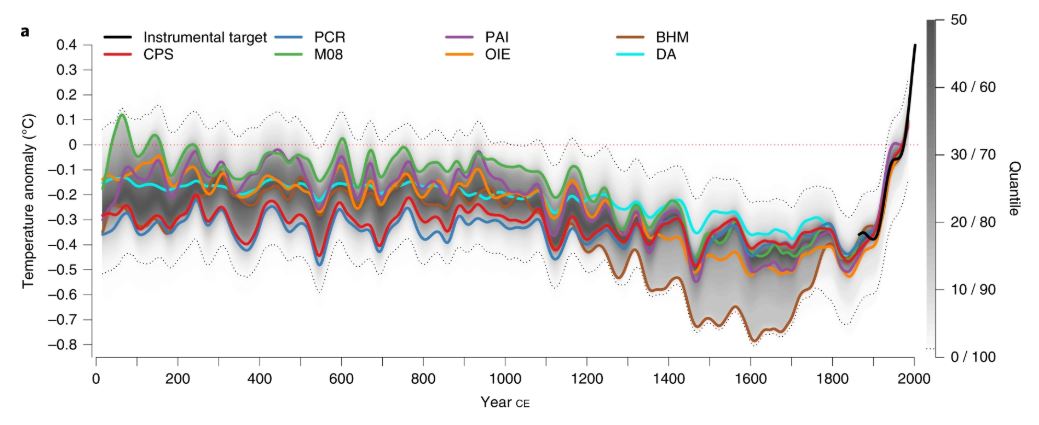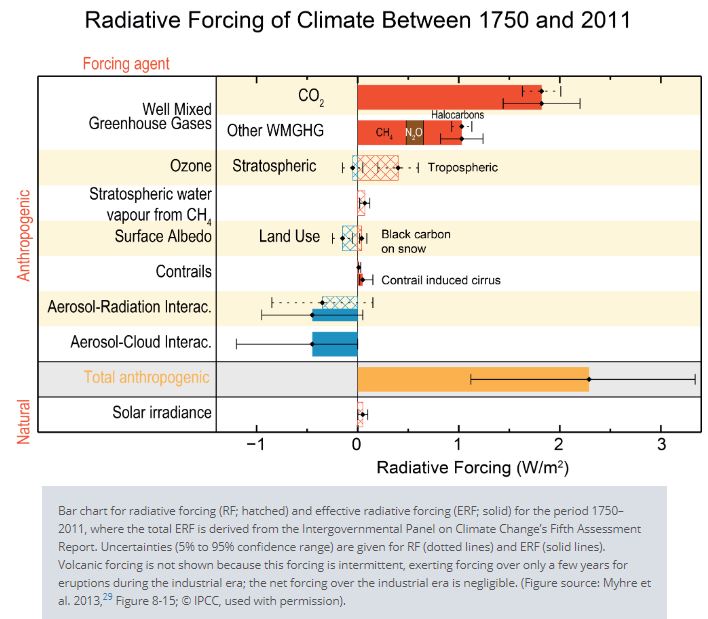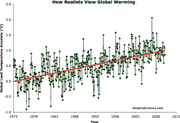Recent Comments
Prev 185 186 187 188 189 190 191 192 193 194 195 196 197 198 199 200 Next
Comments 9601 to 9650:
-
Bob Loblaw at 07:49 AM on 28 August 2019It's satellite microwave transmissions
tkaczevski:
No one has provided an answer to you yet, so let me try. My guess is that this question has not been examined in the scientific literature, but there is likely a reason why.
Let's first think about what your question means. Is the energy in cells phones, etc. a significant amount,, compared to other natural flows? The energy emitted by these sources of EM radiation has to come from somehwere - namely electricity. How much electricity is used to operate these devices?
I don't know, but scientists have looked at the total contribution of human heat production, and it is only 1% of the amount of energy added to the earth-atmosphere system by the effects of added CO2. SKeptical Science has a page on that subject:
https://skepticalscience.com/waste-heat-global-warming.htm
The fraction of total human-consumed energy that is used for cell phones, etc. is going to be very small. A very small proportion of 1% means that these devices cannot compare to the effects of CO2. I think it is safe to say that the EM radiation emitted by these devices is not a significant source of energy to warm the atmosphere.
-
jozef.van.giel@gmail.com at 05:10 AM on 28 August 2019Why German coal power is falling fast in 2019
The main reason why gasemissions from electricity is falling is due to increased import of nuclear energy from France. see also: https://www.electricitymap.org
Moderator Response:[PS] Can you provide data to support that assertion? It seems to be contradicted by other sources (eg here).
-
SirCharles at 01:48 AM on 28 August 2019Why German coal power is falling fast in 2019
Thanks for the article.
"the German power sector’s emissions fell by 20m tonnes of CO2"
If we break that down on a per capita base for these six months we're ending up with a reduction of 1.3kg CO2 per day per capita, equivalent to burning one Imperial pound of coal or half a litre of petrol. Does that sound much?
Chancellor Merkel wanted to get one million EVs on the road by 2022 (2% of the fleet). But currently there are only some 140,000 registered EVs in Germany. Now picture how much more electricity is needed to feed just the 2% of the fleet.
So the outlook is anything but rosy. Germany was sleeping for the last decade. The government's boot licking of the automobile industry (Diesellüge) is now firing back big time.
 Moderator Response:
Moderator Response:[DB] Please reduce image widths to 450 or less.
-
Human 2932847 at 21:55 PM on 27 August 2019The North Atlantic ocean current, which warms northern Europe, may be slowing
Hi, what about this ?
http://ocp.ldeo.columbia.edu/res/div/ocp/gs/
It says,
"The Gulf Stream and future climate change
A slowdown of the Gulf Stream and ocean circulation in the future, induced by freshening of the waters caused by anthropogenic climate change (via melting glaciers and increased water vapor transport into high latitudes) or simply by warming, would thus introduce a modest cooling tendency. This would leave the temperature contrast across the Atlantic unchanged and not plunge Europe back into the ice age or anything like it. In fact the cooling tendency would probably be overwhelmed by the direct radiatively-driven warming by rising greenhouse gases."Is this true, and does that mean AMOC slowdown isn't a worry ?
thanks in advance.
-
MA Rodger at 21:50 PM on 27 August 2019IPCC is alarmist
prove we are smart @134,
With one exception, I have only read the summary of the paper Spratt & Dunlop (2018) 'What Lies Beneath: The understanding of existential climate risk' which you refer to. In short, the need for action on AGW was demonstrated by the science over a quarter of a century ago yet globally our emissions increased as though no such science existed. There is now, policy-wise, an agreement that radical action is needed to prevent a +1.5ºC increase in global temperature, radical as such a goal requires global CO2 emissions in future years to be restricted to something like 120Gt(C). The general message from the science is that such a goal will prevent the very bad AGW effects from happening. Yet in terms of policy, there is still little urgency. The enthusiasm for declaring a Climate Emergency has not yet resulted in any useful policy but let us hope that it will, soon. Spratt & Dunlop (2018) suggest the 120Gt(C) is flawed but it seems to me that its argument would need to be far better presented to be a useful contribution.
Their main criticism is that the science includes those "fat tails" which may make a +1.5ºC world a bit too hot to handle. There has been quite a bit of criticism of the IPCC for failing to make such potential outcomes better known. Most recently, Oppenheimer et al (2019) 'Discerning Experts: The Practices of Scientific Assessment for Environmental Policy' has described well instances of the IPCC's failings (three of the authors have an account of the book HERE). But while there are systemic problems within the IPCC assessments, they do not systematically underestimate AGW. There is perhaps need for the failings of the IPCC assessments to be better understood and in addressing that, I have no criticism of Spratt & Dunlop (2018).
But Spratt & Dunlop (2018) goes further than this. There is a feel of this in their assessment of the impacts of AGW. Their Summary begins:-
"Human-induced climate change is an existential risk to human civilisation: an adverse outcome that will either annihilate intelligent life or permanently and drastically curtail its potential, unless carbon emissions are rapidly reduced."
The word "existential" is usually, in my view, very poorly wielded in regard to AGW. Here, the use "an existential risk to human civilisation" is refreshing to see. But then it is followed by "annihilate intelligent life" which is something I find very difficult to envision.
So this got me delving into one further section of Spratt & Dunlop (2018). The section Carbon Budgets makes a number of points (♣ Not working other GHGs into the budget, ♣ Not evaluating "fat tails" which would reduce carbon budgets to zero, ♣ Relying on models that potentially run cool, ♣ Not defining pre-industrial temperature adequately, ♣ Ignoring actual peak temperatures) but I only see one of these issues that is germane to setting carbon budgets (the cool models). So for me, Spratt & Dunlop (2018) seems to be 'firing from the hip' a bit too much and needs to tighten up its message if they want to make a serious contribution.
-
prove we are smart at 20:01 PM on 27 August 2019IPCC is alarmist
I believe the IPCC reports are probably the most used information to help set climate policy around the globe. However after reading this,
http://climateextremes.org.au/wp-content/uploads/2018/08/What-Lies-Beneath-V3-LR-Blank5b15d.pdf
and part of their summary :
" Climate policymaking and the public narrative are significantly informed by the important work of the IPCC. However, IPCC reports also tend toward reticence and caution, erring on the side of “least drama”, and downplaying the more extreme and more damaging outcomes. Whilst this has been understandable historically, given the pressure exerted upon the IPCC by political and vested interests, it is now becoming dangerously misleading with the acceleration of climate impacts globally. What were lower-probability, higher-impact events are now becoming more likely. This is a particular concern with potential climatic tipping points — passing critical thresholds which result in step changes in the climate system — such as the polar ice sheets (and hence sea levels), and permafrost and other carbon stores, where the impacts of global warming are non-linear and difficult to model with current scientific knowledge.However the extreme risks to humanity, which these tipping points represent, justify strong precautionary management. Under-reporting on these issues is irresponsible, contributing to the failure of imagination that is occurring today in our understanding of, and response to, climate change. If climate policymaking is to be soundly based, a reframing of scientific research within an existential risk-management framework is now urgently required. This must be taken up not just in the work of the IPCC, but also in the UNFCCC negotiations if we are to address the real climate challenge. Current processes will not deliver either the speed or the scale of change required."
So, i was wondering just how correct is this need to modify the scope of the IPCC reports.
" What Lies Beneath" put into words my feelings on our current Aussie state - pretend we care but open more coal mines and do nothing..
This video was also enlightening , a new documentary series , pt 1.
https://www.breakthroughonline.org.au/#!
-
MA Rodger at 18:56 PM on 27 August 2019There's no empirical evidence
The abstract linked @391 which is also the reference supporting the existence of those "measurements of your referral ... claimed to be the result of a 22 per million increase in CO2" which Billev @395 finds so difficult to accept: that abstract is that of Feldman et al (2015) 'Observational determination of surface radiative forcing by CO2 from 2000 to 2010' which can be read in full HERE demonstrating that the effects of the +22ppm increase of atmospheric CO2 2000-10, equal to a climate forcing of +0.26Wm^-2, is directly measureable given the right circumstances
-
Doug_C at 17:25 PM on 27 August 20192019 SkS Weekly Climate Change & Global Warming Digest #34
What happens in the Amazon has impacts across the world, something the current government of Brazil is ignoring as it refuses international aid to fight the 75,000 fires in the region.
-
scaddenp at 13:31 PM on 27 August 2019There's no empirical evidence
So Billev are prepared to actually learn enough physics as to why increasing CO2 to 400ppm from pre-industrial levels can cause such an effect? - (you could see "its just a trace gas" myth but then you have been referred there before without apparently learning anything). Or do you prefer to stick with your ignorance?
Can I assume you would happily walk into a room with 400ppm of cyanide gas - you know how could such a tiny amount of gas be a problem?
-
There's no empirical evidence
billev - "This sounds nonsensical to me" is a pure Argument from incredulity, an erroneous logical fallacy. As scaddenp points out, you've been repeating this very same fallacious argument for at least 3 years. Clearly you're not learning anything from these discussions.
Moderators, might I point out a Comments Policy situation here, namely "Comments should avoid excessive repetition"? Also known as PRATT, a 'point refuted a thousand times'?
-
bozzza at 12:09 PM on 27 August 2019The North Atlantic ocean current, which warms northern Europe, may be slowing
Yes, Brian, it is largely due to coriolis effect ... Salt and heat are simply other factors!
-
bozzza at 12:01 PM on 27 August 2019The North Atlantic ocean current, which warms northern Europe, may be slowing
Salt doesn't freeze!
-
TVC15 at 11:15 AM on 27 August 2019Medieval Warm Period was warmer
@258 scaddenp; 259 Daniel Bailey
Thank you so much! I love how much I learn posting here! :)
-
billev at 11:05 AM on 27 August 2019There's no empirical evidence
Scaddenp, the measurements of your referral were claimed to be the result of a 22 per million increase in CO2. This would mean that the observed heat increase was caused by an increase of one part of CO2 per each 45,454 parts of atmosphere. This sounds nonsensical to me.
Moderator Response:[DB] Please note that posting comments here at SkS is a privilege, not a right. This privilege can and will be rescinded if the posting individual continues to treat adherence to the Comments Policy as optional, rather than the mandatory condition of participating in this online forum.
Moderating this site is a tiresome chore, particularly when commentators repeatedly submit offensive, repetitive (even after being disproven), off-topic posts or intentionally misleading comments and graphics or simply make things up. We really appreciate people's cooperation in abiding by the Comments Policy, which is largely responsible for the quality of this site.
Finally, please understand that moderation policies are not open for discussion. If you find yourself incapable of abiding by these common set of rules that everyone else observes, then a change of venues is in the offing.Please take the time to review the policy and ensure future comments are in full compliance with it. Thanks for your understanding and compliance in this matter, as no further warnings shall be given.
-
scaddenp at 10:38 AM on 27 August 2019There's no empirical evidence
Just reviewed billev posting history on this site. Hmm. I think the response I gave him in 2016 here still applies. What actually is the point of asking the same thing and then running away from the answers? At this point, billev is engaging in evasive repetition and running away when evidence is posted. I am not sure I can find any evidence that he has read single paper that he has been pointed to.
-
Bob Loblaw at 10:35 AM on 27 August 2019There's no empirical evidence
Frankly, I don't think billev is interested in any answers you give him. He's had lots of opportunity to learn from his many ill-posed questions here. What he's really saying is that there will never be any evidence that he will accept. As long as he dismisses any and all evidence, he can conitnue in his beliefs and remain confident of his position.
Do not feed the troll.
-
David Kirtley at 10:03 AM on 27 August 2019Hockey stick is broken
TVC15 @160. Denier's statement: "State with specificity what the exact average global temperature should be now".
This is a common technique and it's a bit of a strawman argument. Scientists don't make any claims about what the "ideal" temperature "should be". There is no "perfect" temperature for the earth.
But, there are ideal temperatures for sustaining a global human civilization. We need stable temps to grow our food, we need stable sea levels to insure that our major cities are not inundated, etc, etc.
-
Daniel Bailey at 08:36 AM on 27 August 2019Medieval Warm Period was warmer
Time for some updates to this thread:
"'No doubt left' about scientific consensus on global warming, say experts"
The Guardian article then cites 3 brand-new studies, just published, which show that:
"there has never been a period in the last 2,000 years when temperature changes have been as fast and extensive as in recent decades"
Neukom et al 2019 - No evidence for globally coherent warm and cold periods over the preindustrial Common Era
PAGES 2K 2019 - Consistent multidecadal variability in global temperature reconstructions and simulations over the Common Era
“This paper should finally stop climate change deniers claiming that the recent observed coherent global warming is part of a natural climate cycle. This paper shows the truly stark difference between regional and localised changes in climate of the past and the truly global effect of anthropogenic greenhouse emissions,” said Mark Maslin, professor of climatology at University College London.
Bronnimann et al 2019 - Last phase of the Little Ice Age forced by volcanic eruptions
"global mean annual temperatures are higher now than any time in the last 2,000 years, with the middle of the 20th century either matching or exceeding Common Era temperatures as well"
Tardif et al 2019 - Last Millennium Reanalysis with an expanded proxy database and seasonal proxy modeling
“But even when we push our perspective to the earliest days of the Roman Empire, we cannot discern any event that is remotely equivalent — either in degree or extent — to the warming over the last few decades.”
St George 2019 - Aberrant synchrony of present-day warming
Related LINK
This skeptic meme is stone dead. Stick a fork in it, it's done.
-
There's no empirical evidence
billev - It's unclear to me what your particular complaints are, but there are more specific Skeptical Science threads for various aspects of your complaints. If you can be more clear, I would suggest taking the discussion to the appropriate thread.
- You don't trust the surface temp records? They are quite solid, and show considerable warming despite the statistical approaches used: skepticalscience.com/surface-temperature-measurements-advanced.htm
- You don't believe we're the cause? Lots of attribution evidence shows that we are - natural forcings would have caused a temperature decrease over the last 50 years, and we have a statistically significant warming matching anthropogenic forcings: skepticalscience.com/a-comprehensive-review-of-the-causes-of-global-warming.html
- You for some reason don't believe the atmospheric changes are real? Lots of empirical proof for that, including direct spectral measurements of radiative changes over the last few decades: skepticalscience.com/empirical-evidence-for-global-warming-intermediate.htm
Now, if you don't have any reasons, supported by evidence, to disagree with those aspects of the global temp. record, it's linkage to greenhouse gas atmospheric changes, and attribution to human causes, your objections IMO come down to an Argument from incredulity, which is a logical fallacy. I'm more than willing to be proven wrong about that, but you're going to have to support your arguments.
-
TVC15 at 08:26 AM on 27 August 2019Hockey stick is broken
@ 161 Daniel Bailey
Thank you so much for that great response and all the data!
-
Daniel Bailey at 08:20 AM on 27 August 2019Medieval Warm Period was warmer
Specifics on proxy datasets can be found here.
-
scaddenp at 08:10 AM on 27 August 2019Medieval Warm Period was warmer
yes. Where no temperature measurements exist, then proxies are all you have.
Dont let a denier take you down the path of believing that climate theory depending on paleoclimate studies. Paleoclimate studies are useful testing grounds - if our current understanding of climate cannot reproduce measurements of temperature given the uncertaintites in the temperature measurement and our understanding of the forcings operating at the time, then the theory would be in trouble. Not the case. Paleoclimate is also useful in constraining climate sensitivity. However, uncertainties in estimating solar output, aerosols, albedo and temperature all create significant limits compared to analysing the physics of the climate system today.
-
scaddenp at 08:02 AM on 27 August 2019There's no empirical evidence
billev - I am struggling a bit to understand your issue. The surface air temperature have gone up and that is consistant with the increased irradiation of the surface. While you ask about "reduction in outgoing longwave radiation causes any temperature change", more relevant is measured increase in irradiation of the surface (though one is simply the reflection of the other assuming conservation of energy). More recent direct measurement of the increased irradiation due to CO2 at the surface is here. Are you proposing Stephan-Boltzmann law does not apply? If the sun increased its radiation by 4W/m2 and you noticed the temperature increasing as it does today, would you be saying there "was no evidence that increased output from the sun was raising temperatures"? If so, then what kind of evidence are you looking for - or are you engaging in sophistry to support a belief grounded in ideology/identity rather than science?
-
billev at 07:29 AM on 27 August 2019There's no empirical evidence
I am talking about air temperature measurements that are used to calculate the global mean air temperature.
-
Daniel Bailey at 07:22 AM on 27 August 2019Hockey stick is broken
TVC15, the current global mean temperature for the Earth "should be" one dictated by the sum balance of forcings and feedbacks that drive temperatures. As those are not in balance due to human activities, the global mean temperature is increasing as a result. Global mean temperatures will continue to increase as long as temperatures are not in balance with forcings, which they are not, as long as the burning of fossil fuels continues as they are currently used.
Scientists have evaluated all natural forcings and factors capable of driving the Earth's climate to change and it is only when the anthropogenic forcing is included that the observed warming can be explained.
Natural vs Anthropogenic Climate Forcings, per the NCA4, Volume 2:
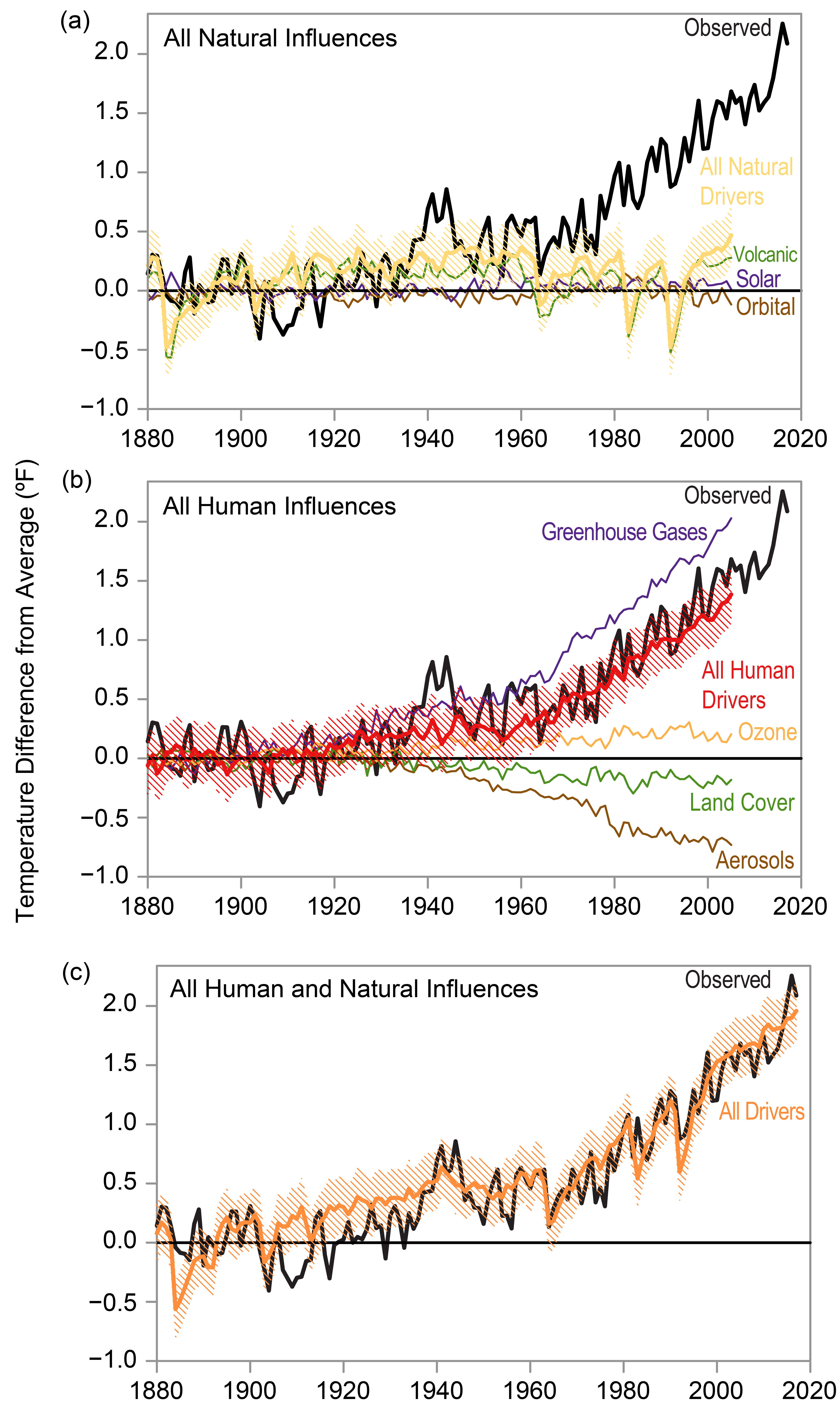
Changes in the sun's output falling on the Earth from 1750-2011 are about 0.05 Watts/meter squared.
By comparison, human activities from 1750-2011 warm the Earth by about 2.83 Watts/meter squared (AR5, WG1, Chapter 8, section 8.3.2, p. 676).
What this means is that the warming driven by the GHGs coming from the human burning of fossil fuels since 1750 is over 50 times greater than the slight extra warming coming from the Sun itself over that same time interval.
-
TVC15 at 07:09 AM on 27 August 2019Hockey stick is broken
I posted in a forum about the purpose of the "Hockey Stick" study and the fact that numerous proxy studies have been performed confirming the original hockey stick conclusion: that the 20th century is the warmest in the last 1000 years and that warming was most dramatic after 1920.
A denier swooped in and made this snarky comment and expects me to make a statement answering their question.
Which is immaterial and irrelevant.
State with specificity what the exact average global temperature should be now and the peer-reviewed science to support your conclusion.I have no idea how to answer as I don't know what the current global temperature "should" currently be?
-
Xulonn at 06:35 AM on 27 August 2019Millions of times later, 97 percent climate consensus still faces denial
Doug_C @22
I noticed that you used "tar sands" and "dilbit" (diluted bitumin) rather than "oil sands" and "oil" to correctly identify that Canadian fossil fuel energy resource.
However, I've noticed that even the Canadian government uses the incorrect term "oil sands" to minimize the negative connotation of the real name of the resource.
-
TVC15 at 06:31 AM on 27 August 2019Medieval Warm Period was warmer
Hi,
How is past climate data collected? Is it through proxy studies analyzing a variety of different sources such as corals, stalagmites, tree rings, boreholes and ice cores?
Thanks
-
There's no empirical evidence
billev - According to the IPCC scientific synthesis:
Scientific evidence for warming of the climate system is unequivocal.
There's a good and approachable summary of this by NASA that's worth reading, at climate.nasa.gov/evidence/ I'm afraid that the science, the evidence, just don't agree with your claims.
-
Eclectic at 02:38 AM on 27 August 2019There's no empirical evidence
Billev @385 and @386 ,
before you ask for evidence, you must first define what you are talking about.
So . . . what aspect of global air temperature do you mean? Air temp at the surface (e.g. standard meteorological station thermometers) ?
Air temp at 10,000 feet altitude (radiosonde balloon thermometers; or calculated from microwave detection from satellites) ? Air temp at the tropopause; temp at the lower stratosphere; at the upper stratosphere ?
What about sea surface temperature ? Important, surely !!
How is the "global annual mean temperature" calculated ?
Is the melting of polar ice counted as a global temperature change? If not, why not? (Global ice-melt is occurring at approx 500 cubic kilometers per year. That's a hefty chunk of ice, by anyone's measure!! )
Is the ongoing rise in sea level — from the warming of the ocean, as well as ice-melt — is that taken as evidence of temperature change ? If not, why not?
Ain't so simple . . . even before we start measuring whether there is, or isn't, a reduction of outgoing radiation.
-
MA Rodger at 02:18 AM on 27 August 2019There's no empirical evidence
billev @385 & 386.
As well as setting out some quite complex questions that could be interpreted in different ways and which could do with being clarified, it would be useful to specifically understand why you say "there appears to be no evidence"?
It occurs to me that this sounds a bit like a passage in the chat Roy Spencer gave at the Heartland shindig at the end of last month. (His grand assertion was "And as we add CO2 the theory says we've reduced the ability of the earth to cool itself by about one percent. That's according to theory not measurements. None of our satellite measurements of any kind are good enough to measure that. It's a theoretical expectation." Of course, as is usually the case with statements from Roy Spencer, it is wrong.)
And as the subject is quite a complex one, it might be better to kick-off discussing it with a clear understanding of what you are actually asking about. Thus, could you explain why you say "there appears to be no evidence"?
-
tkaczevski at 01:47 AM on 27 August 2019It's satellite microwave transmissions
Thank you for the math regarding satellites. I would be curious what effect all microwave communications have on the climate. Cell phones towers, WiFi, phones and other devices seem to be working in the water heating frequency range. Has there been a study calculating the effect of all microwave communication on global heating? What would it take to change the EM frequencies of communication to avoid the water-warming ones?
-
billev at 00:52 AM on 27 August 2019There's no empirical evidence
There appears to be no evidence that the reduction in outgoing longwave radiation causes any temperature change that is detectable by the measuring devices used to determine global air temperature.
-
billev at 00:43 AM on 27 August 2019There's no empirical evidence
What evidence is there to show that the magnitude of the reduction in outgoing longwave radiation has had any measureable effect on World-wide temnperature measurements used to arrive at a global annual mean temperature?
-
One Planet Only Forever at 00:42 AM on 27 August 20192019 SkS Weekly Climate Change & Global Warming Digest #34
I agree with the understanding that "...sovereignty is not the right to damage your neighbours interests."
Sovereignty also does not defend actions harmful to the future of humanity.
Said another way, Self-Interest cannot be allowed to result in Actions that are beneficial to a portion of the population by being harmful to Others or the Future of Humanity. In "Reasons and Persons" (1984), Derek Parfit presented a detailed and robust rational ethical proof that self-interest as a Governing Principle can be expected to produce harmful results.
What is most important for the sustainability of any culture or nation (or business) is that its Governance incorporates improving awareness and understanding of what is required for sustainability (the achievement and improvement on the Sustainable Development Goals). Failure to make understandably required Governance corrections compromises the future of the nation, culture, or business.
Within Collectively Governed cultures, nations, and businesses (those where employees have significant influence), it is well understood to be beneficial for there to be penalties to limit the amount of harmful pursuit of self-interest by individuals or groups within the Governed population (or its competition). It is also understood that rewards for helpful behaviour can also be beneficial to the sustainability of the culture, nation, or business.
The problem regarding Climate Change, and many other developed human activity impacts requiring correction, is that International Law does not effectively exist (only things like Universal Declarations, Accords, Treaties, Pacts, and Agreements that sort of influence leadership).
Nations and States or Provinces, and to some degree cities (and of course businesses) can develop rules and laws governing what happens within their populations. But Nations and International Businesses are hard to govern through those external legal mechanisms (even China's central government struggles to govern what happens in Regions within China). And of course the lack of International Law leaves decisions about corrective collective national actions, like trade sanctions or agreements to breech sovereignty to intervene, up to the fickleness and potential harmfulness of self-interested leadership.
People like Stephen M. Gardener are pushing for International Rule development and corrections. But many powerful people are resisting the Governance improvements because they prefer to get away with pursuing "Their Self-Interests" and defending "Their Developed Status in the Status Quo".
-
nigelj at 17:52 PM on 26 August 20192019 SkS Weekly Climate Change & Global Warming News Roundup #34
How climate change is leading to larger and more frequent forest fires: See how a warmer world primed California for large fires.The state is just hotter and drier than it used to be, and that's driving a trend toward larger fires.
Climate Change Is Fueling WildfiresNationwide, New Report Warns
-
nigelj at 17:45 PM on 26 August 20192019 SkS Weekly Climate Change & Global Warming News Roundup #34
Deb @3, there are more fires than usual in the Amazon Rainforest this year but it appears to be caused deliberately to clear land. Climate change doesn't really start forest fires, except for possibly higher lightening strikes in some places, and instead climate change makes fires larger because land is hotter and drier. So its this scale issue that should be pointed out to the denialists.
As to convincing people that climate is changing etc, I think just stick to robust facts. Many denialists are probably beyond convincing, because for them its become political so views become rigid, but we can still chip away at them, and convince more open minded people listening in.
-
nigelj at 17:34 PM on 26 August 20192019 SkS Weekly Climate Change & Global Warming Digest #34
The Amazon rainforest also creates rain.
"By the middle of the century, deforestation in the Amazon could reduce rainfall by up to 20%, even in areas far from those that have lost trees."
"Tropical forests release huge volumes of water to the atmosphere, where it moves around and is recycled as rainfall — but pasture and farmland do not. Delphine Zemp at Humboldt University in Berlin and her colleagues modelled how the loss of forests could affect rainfall across South America. They calculate that if deforestation continues at roughly its current rate, dry-season rainfall will decrease by 8% across the Amazon basin by 2050, with localized hotspots losing up to 20% of their rain."
"The greatest reductions in rainfall were seen in the southwestern part of the Amazon, and could make the region more vulnerable to disturbances such as extreme drought and fire. Rainfall loss from deforestation could therefore lead to further environmental degradation."
This could affect neighbouring countries as well. Imho sovereignty is not the right to damage your neighbours interests. If the situation is not resolved diplomatically, it could lead to serious conflicts. Bolsonaro is not providing good leadership.
-
scaddenp at 13:13 PM on 26 August 2019Residence Time and Prof Essenhigh
Since rate of removal is proportional to gradient, and sea is gradually becoming more saturated, then over time spans of 100s to 1000s of years, CO2 removal must slow (in fact as oceans heat, they will expel CO2 not absorb it).
-
Deb9714 at 12:44 PM on 26 August 20192019 SkS Weekly Climate Change & Global Warming News Roundup #34
How to answer people who say the fires in Brazil, and elsewhere are normal for this time of year, it's summer, there is no increase in the number of fires, blah, blah, blah, nothing to see here folks it's MSM spreading alarm, and NASA says nothing to worry normal this time of year. IMO it's misdirection. Please, someone, direct me to a link or links.
Thank you
Moderator Response:[JH] See:
EXPLAINER-Why are the Amazon fires sparking a crisis for Brazil - and the world? by Jake Spring, Reuters, Aug 25, 2019
[DB] Also see this,
"Cumulative active fire detections through 8/22/2019 from MODIS and VIIRS confirm that 2019 is the highest fire year since 2012 (the start of the VIIRS record) across the seven states that comprise the Brazilian Amazon. In addition, fires in 2019 are more intense than previous years, measured in terms of fire radiative power, consistent with the observed increase in deforestation"

-
Bob Loblaw at 12:02 PM on 26 August 2019Residence Time and Prof Essenhigh
DaveBurton:
You seem to be using terms like "fact" and "observation" a lot when what you are saying does not fit their definitions. You also say "If you start with a physically impossible assumption, you get a physically impossible result." Let's look at the model you present in that light.
When you present the model in comment #27, you claim:
Start with the observation that the rate at which natural systems (oceans & terrestrial biosphere, mainly) remove CO2 from the air is governed chiefly by the CO2 level in the air.
This is only crudely close to reality. The rate of CO2 from the atmosphere to the land and oceans requires a gradient, not a concentration. The rate will depend not only on that gradient, but on the efficiency that CO2 can move along that gradient. In fact, the model you present has that explicitly, where in your code you say (bolding mine):local($co2elevation) = $co2level - 295.1;
local($ratio) = 47.73;
if ($co2level <= 295.1) {
$removalrate = 0;
} else {
$removalrate = $co2elevation * 0.0233;
}The gradient is the result of the expression "$co2level - 295.1", and the efficiency of movement along that gradient is the value 0.0233 in the expression "$co2elevation * 0.0233". (That coefficient must have units that include a per unit time term)
In this model, there is an implicit assumption that the only stable CO2 level is 295.1 pm. Any excess above that value will be removed until CO2 returns to 295.1 ppm.
Oddly, it also state that the removal rate is zero if CO2 concentration falls below that point. Thus, it assume that there are no natural processes capable of lowering CO2 level below that majick value of 295.1 ppm. This falls into the "not even wrong" category, as we have indirect observations of CO2 levels much below this during the last glacial periods.
The model clearly starts with a physically impossible assumption. So, in your own words, it produces a physically impossible result.
...But let us consider the possibility that something majick can occur, so that the surface can somehow maintain a concentration of 295.1 ppm so it can suck the CO2 out of the air any time the atmospheric concentration is >295.1 ppm. What does it do with that CO2? It can't stay at the surface, because in the model the surface is always capable of sucking CO2 out of the air even if the atmospheric concentration is only 295.2 ppm. There must be some gradient to move CO2 away from the surface into the oceans or land.. And whatever is moving it into the coeans and land must majickally stop when atmospheric CO2 drops to 295.1 ppm, because if it didn't then the surface CO2 concentration would have to drop if there is no replacement of CO2 from the atmosphere. Remember? In your code you said:
if ($co2level <= 295.1) {
$removalrate = 0;Now, you may try to argue that this model only applies to the special CO2 that is added due to human activities. To make that claim you are going to have to provide some sort of plausible mechanism by which nature can tell the difference between an atmospheric CO2 molecule that came from burning fossil fuels, and one that came from the multitude of natural sources. (Hint: it can't.)
To loosely quote Monty Python's Oscar Wilde sketch, the model you present is not a "gleaming shaft of gold".
-
scaddenp at 07:33 AM on 26 August 2019Greenland is gaining ice
icowrich - try http://gravis.gfz-potsdam.de/greenland. Regular updates from FO are really just getting started.
-
One Planet Only Forever at 07:32 AM on 26 August 20192019 SkS Weekly Climate Change & Global Warming News Roundup #34
nigelj,
Efforts to improve awareness and understanding of the corrections and new developments that are required to achieve and improve on the Sustainable Development Goals threaten the developed perceptions of status, and potential for increased status relative to Others, of the many correction resistant (and disliking of Others) sub-groups that can be seen to be gathering in support of United Right-wing groups around the world.
The developing Right-wing groups (including transformations of leadership of Right-wing groups such as the US Republicans) are clearly becoming collectives of sub-groups that are threatened by improvements of the future of humanity because those improvements require many aspects of the developed status quo to be 'sacrificed and given-up on' by the sub-set who would continue to benefit from, or hope to benefit from, not having the corrections and improvements occur.
And those sub-groups can be seen to be willing to have the party they support act in unacceptable harmful ways as long as their primary correction resistance interests are being achieved. That can result in people who declare that they want to see leadership actions that are significantly helpful Climate Actions actually choose to vote for leadership that has declared and proven to desire to be harmfully resistant regarding Climate Actions.
The New York Times has published Jo Becker's investigation into the global Right-wing pursuing disinformation campaigns regarding things happening in Sweden with "The Global Machine Behind the Rise of Far-Right Nationalism". And the Washington Post Editorial Board has added the Editorial "Right-wing extremists are a global problem. They need a global response." which references the New York Times reporting of the Swedish example of what the global Right-wing are trying to get away with to become 'harmfully and unjustly more popular'.
What is clearly missing is a powerful corrective response from the Right-Wing. Many in the Right-wing seem to fear that openly challenging what the Right-wing are becoming could ostracize them from the group they have developed a powerful addiction to. There can be many reasons for their reluctance. Jonathan Haidt has identified many things Right-wingers may allow to overpower their ability to reasonable determine how they can be Helpful, including impulses like: Unquestioned Loyalty to their ingroup, Subservience to Authority within their ingroup, Desire for Purity as perceived by their ingroup, or the Liberty to believe 'whatever they want' as long as it is consistent with the desires of their ingroup and its leadership.
-
icowrich at 05:54 AM on 26 August 2019Greenland is gaining ice
GRACE data ends in 2016. Do we have GRACE-FO data, yet, so we can extrapolate what has happened in the intervening years?
-
icowrich at 05:53 AM on 26 August 2019Greenland is gaining ice
If we're losing, on average, 0.01% of total Greenland ice mass per year, then we can expect to lose 1% of the total mass in a century. That doesn't sound so bad until you realize it assumes the melt rate does not accelerate.
-
MA Rodger at 03:15 AM on 26 August 2019Residence Time and Prof Essenhigh
daveburton @35,
It would be better if you could come up with some support for your advocacy of Spencer's silly model rather than presenting unsupported assertions that it is "correct". All we have otherwise is the 'big ocean' which you say must be thus effectively an infinitely large sink. You tell us "Mankind has increased CO2 level in the atmosphere by about 47%. We've increased carbon content in the oceans by only about 0.4%." (Note Roy doesn't reckon to your 47% figure.)
If that was correct that the percentage ocean carbon increase has to match the atmospheric percentage increase (which it doen't), that will have massive implications for a whole lot of stuff. (1) The projections of CO2 levels in the RCP scenarios would be massively revised if Spencer's model were anything like reflective of reality. Now I know Spencer denies that CO2 has any sigificant warming impact on the climate but this CO2 model would give him a brilliant second string to his contrarian bow (and how he needs one, as the other ones have proved pretty useless). (2) The implications for ocean acidification are massive and for fresh water it doesn't bear thinking about. (3) The low CO2 levels of the ice ages will have to be entirely re-thought. If atmospheric CO2 levels drop by a third, there would be 13,000Gt(C) being pumped out the oceans and into .... where? Golly, that's a tricky one!!
Yet (and I note that up-thread I wrongly called it a blog from last year 2018) in the four months since this model was posted (April 2019), I see no reference to it beyond that blog. It didn't even get a posting on the planet Wattsupia (which is a really bad sign!!!) Is Spencer too busy chatting to fellow contrarians at the Heartland Institute (where he seemed to have said nothing about his grand revalation)? So why the silence? My take is that Spencer's model is so embarassing that Spencer hopes it goes away. So, daveburton, you are not helping the reputation of poor old Roy with your insistence that his model is correct (when it patently isn't).
By the way, that long fat tail may be a lot stumpier than Spencer's model implies. The idea that the oceans are sucking up carbon at a rate constant with the level of atmospheric CO2 above an equilibrium of 295ppm(v) doesn't seem to hold over the period 1958-2010. Rather than a constant level of uptake, the rate has dropped by a half from the start of this period (1959-78) to the end of this period (1991-2010). That isn't exactly constant over centuries as Spencer's model assumes.
In truth, daveburton, your words do correctly assess Spencer's model when you say "If you start with a physically impossible assumption, you get a physically impossible result." That is exactly what Spencer's silly exercise in curve-fitting has done.
-
Eclectic at 00:19 AM on 26 August 2019Residence Time and Prof Essenhigh
Daveburton ,
I appreciate your comedic comments about wires and feedbacks. Although they belong in an earlier lesson than Homeostasis 101.
Likewise, Dr Spencer's Simple Model provides farcical amusement, thanks to its disconnect with reality — why yes, its curve fits reality at least in part . . . just as the Aristotelian model of the planets is a moderately good fit to the observed motion of the planets across the night sky, at least in part!! But unlike our Spencer, our Aristotle had a decent excuse for his blunders.
Daveburton, when I mentioned sitting back and observing "another 40 years or so" , I was of course not alluding to the future experience of someone as unimportant as me (or possibly you). Or perhaps you were just pulling my leg about "that", too.
No . . . I was alluding to something far more important: namely the human race. And here we get to the crunch, Daveburton, the really important point about Spencer's far-too-simple-to-be-scientifically-useful model.
# What do you think was the actual underlying reason for Dr Spencer to publicize his strange little "Simple Model".
( Not for comedy, I suspect. Nor for the edification of genuine climate scientists.)
-
Eclectic at 23:51 PM on 25 August 2019There is no consensus
CThompson @819 ,
I'm sure that you would agree that "scientists" exist on a spectrum of climate expertise, ranging from extensive climate expertise (involving much research & publication in respected journals) . . . . across to those with almost zero knowledge of the complexities of climate-related science (e.g. the 19,000 scientists who signed the Oregon Petition two decades ago).
Unsurprisingly, all surveys examining this point do indicate that the higher the climate expertise the higher the "mainstream" consensus percentage.
CThompson, since you seem unhappy to countenance that point, then perhaps you should try coming at the consensus percentage, from quite the opposite direction :- Identify the percentage of climate scientists who are outside the consensus.
That would be much easier — since they are so few in number. And there is an important second identification which you must make. In order to cull out the undeserving (i.e. the crackpots, the nutcases, and the Gone-Emeritus types undeserving of your approbation) -— you must simultaneously identify the valid evidence which supports their "contrarian" views.
# Because if they don't have any valid evidence for their opinions, then they are not really countable as scientists.
Shouldn't take you long at all !
-
daveburton at 21:52 PM on 25 August 2019Residence Time and Prof Essenhigh
Eclectic wrote, "your heated-wire analogy is even wider of the mark..."
It is just a simple example illustrating a general principle. It's how negative feedback systems work. If the removal rate increases with system output level, that's a negative feedback mechanism. A constant forcing input will then result in a plateau at "equilibrium," where the negative feedback has caught up with the constant input.
That's true when the input forcing is energy added to your toaster via electricity, and the negative feedback mechanism is radiative & convective heat loss from a nichrome wire.
It's also true when the input forcing is CO2 added to the atmosphere, and the negative feedback is CO2 removal from the atmosphere via dissolution in the oceans and terrestrial plant uptake.
The principle is true regardless of whether the negative feedback is linear or nonlinear. For the nichrome wire example, there are actually three significant negative feedbacks, all with different transfer functions: radiative heat loss goes up in proportion to the 4th power of the temperature relative to 0K, convective heat loss goes up in approximate proportion to the temperature difference between the wire and ambient air, and the resistance of the wire also goes up with temperature. The fact that all three have different-shaped transfer functions doesn't affect the conclusion: because they are negative feedbacks, a constant input (forcing) must result in a plateuing output, gradually approaching equilibrium.
Eclectic continued, "The design of the Simple Model fits at best tangentially with physical reality."
It fits extremely well for the period for which we have accurate measurements:
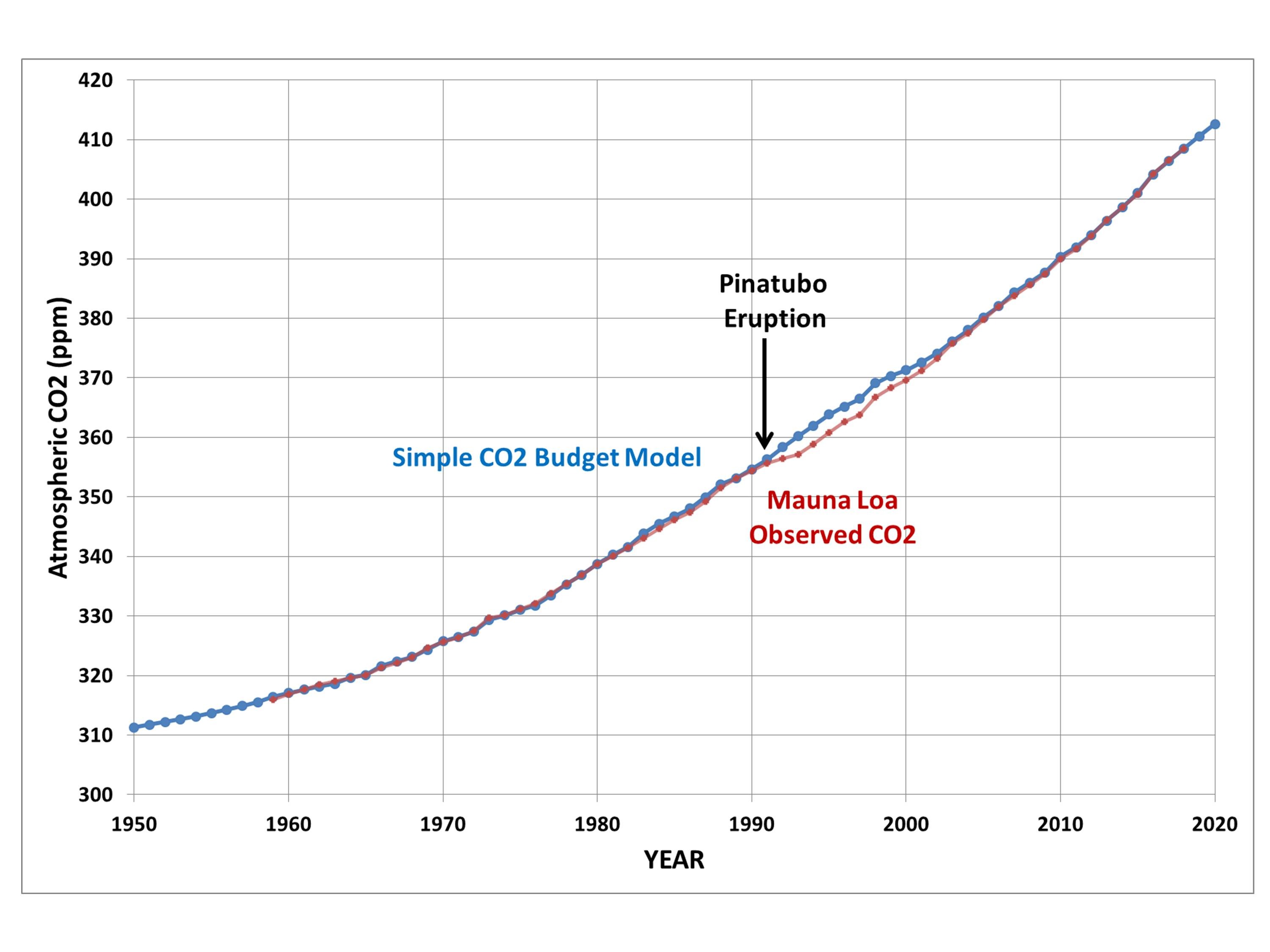
Eclectic continued, "nor do we have the luxury of time to sit back and observe another 40 years or so, as the Simple Model diverges from the (complex) real world."
Well, I obviously don't, at my age.
But mankind does have that luxury, and you should not expect Roy's Simple Model to diverge much from reality over the next 40 years. It is the "long, fat tail" (due to increased carbon levels in non-atmospheric reservoirs) which is not modeled by the Simple Model. Regardless of what happens with CO2 emission rates, CO2 removal over the next 40 years will be dominated by the removal mechanisms which the Simple Model models well.Eclectic continued, "the paleo evidence demonstrates the falsity of Spencer's too-simple Simple Model."
All models are false, but some are useful. Roy's Simple Model is very useful. It is a very good fit to measured reality, and it will continue to be a good fit as long as the CO2 removal mechanisms which are currently most important continue to be most important. When CO2 levels drop below 300 ppmv, and the accumulation of anthropogenic carbon in non-atmospheric reservoirs becomes an important factor affecting atmospheric CO2 levels, then his Simple Model will diverge from reality.
MA Roger wrote, "Yes, the oceans are big. Yes, the oceans contain contain sixty-times the carbon found in the pre-industrian atmosphere (which was in full equilibrium with the oceans). But what has that got to do with your "fact"?"
Mankind has increased CO2 level in the atmosphere by about 47%. We've increased carbon content in the oceans by only about 0.4%.
So, why does that matter? Because it is that accumulation of carbon in non-atmospheric reservoirs that is not modeled by Roy's Simple Model. In other words, his Simple Model assumes the other carbon reservoirs have infinite capacity.
That's a pretty good simplifying assumption, as long as the anthropogenic increase in atmospheric CO2 dwarfs the anthropogenic increase in carbon in other reservoirs. It will diverge from approximating reality during the "long, fat tail," when the anthropogenic increment in atmospheric carbon dioxide no longer dwarfs the anthropogenic increase in carbon in other reservoirs.
MA Roger wrote, "it is very odd that they would ever allow atmospheric levels to remain constant while the ocean absorbed a large constant flux of dissolving CO2."
Atmospheric levels will remain constant when transfer of carbon to the oceans and other carbon reservoirs removes CO2 from tha air as quickly as anthropogenic emissions are adding it. (They're currently removing it only about half as fast as we're adding it.)
MA Roger asked, "Have you actually examined the workings of Spencer's model?"
Of course.
MA Roger wrote, "If you set the future anthropogenic emissions to a fixed value... atmospheric CO2 levels tend to a constant value"
Which is, of course, correct.
MA Roger wrote, "while negative emissions, suck out 15Gt(C)/yr and by AD2191 the atmosphere is entirely denuded of CO2. daveburton, doesn't that strike you as "very odd"?"
Not at all. If you start with a physically impossible assumption, you get a physically impossible result. The only thing I can think of which could possibly remove a net 15 GtC/year from the atmosphere when CO2 levels are below 300 ppmv, is some idiot genetically engineering a fast-growing, fast-propagating C4 tree.
Please don't do that! The Earth doesn't need another K-T Extinction! -
Estoma at 21:29 PM on 25 August 2019There is no consensus
I've been lurking here at Skeptical Science and Real Climate since their inception. One of the first things I learned was about the natural carbon cycle. Put that part aside. The emmissions being talked about are the ones created by fossil fuels. That CO2 has a different signature from the natural CO2.
https://skepticalscience.com/co2-increase-is-natural-not-human-caused.htm
There is such a thing as zero emmissions. You just have to learn what type is being talked about.
Prev 185 186 187 188 189 190 191 192 193 194 195 196 197 198 199 200 Next































 Arguments
Arguments





















